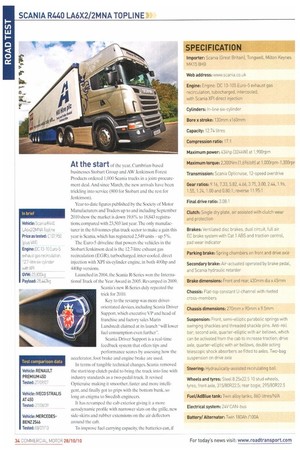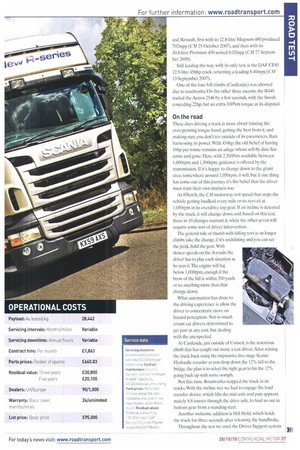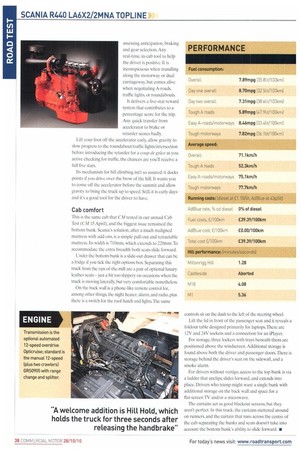At the start of the year. Cumbrian-based businesses Stobart Group
Page 34

Page 36

Page 37

Page 38

If you've noticed an error in this article please click here to report it so we can fix it.
and AW Jenkinson Forest. Products ordered 1.000 Scania trucks in a joint-procurement deal. And since March, the new arrivals have been trickling into service (800 for Stobart and the rest for Jenkinson).
Year-to-date figures published by the Society of Motor Manufacturers and Traders up to and including September 2010 show the market is down 19.8% to 18,843 registrations, compared with 23,503 last year. The only manufacturer in the 6.0-tonnes-plus truck sector to make a gain this year is Scania, which has registered 2.549 units — up 5%.
The Euro-5 driveline that powers the vehicles in the Stobart/Jenkinson deal is the 12.7-litre exhaust gas recirculation (EGR), turbocharged, inter-cooled, direct injection with XPI six-cylinder engine, in both 400hp and 440hp versions.
Launched in 2004, the Scania R-Series won the International Truck of the Year Award in 2005. Revamped in 2009, Scania's new R-Series duly repeated the trick for 2010.
Key to the revamp was more driverorientated devices, including Scania Driver Support, which executive VP and head of franchise and factory sales Mann Lundstedt claimed at its launch will lower fuel consumption even further".
Scania Driver Support is a real-time feedback system that offers tips and performance scores by assessing how the accelerator, foot brake and engine brake are used.
In terms of tangible technical changes. Scania removed the start/stop clutch pedal to bring the truck into line with industry standards as a two-pedal truck. It revised Opticruise making it smoother, faster and more intelligent, and finally got to grips with the bottom bunk, so long an enigma to Swedish engineers.
It has revamped the cab exterior giving it a more aerodynamic profile with narrower slats on the grille, new side-skirts and rubber extensions on the air deflector's around the cab.
To improve fuel carrying capacity, the batteries can, if required. be relocated to the back end of the chassis, and diesel tanks are deeper and wider. Quarter elliptic rear suspension is now two-bag, and a little lighter than previous designs. claims the manufacturer CM's test truck, with the aforementioned DC 13-10 12.7-litre Euro-5 EGR engine, is rated at 434hp with 2,300Nm torque. Below it is the 394hp. which has 2,100Nm torque at its disposal, and above is the 473hp with 2,500Nm.
Transmission is either the optional automated 12-speed overdrive Opticruise. or standard manual 12-speed (plus two crawlers) GRS0905 with range change and splitter.
On top of the chassis is the CR19 Topline twin-bunk cab in standard specification.
Added extras include a battery master switch, extended side skirts, locking fuel caps. two luxury leather seats, leather steering wheel, exclusive interior lighting and metallic paint.
Recommended retail price for the R440 LA6x2/2MNA is £107,950, which includes the GRS0905R retarder, Hill Hold, and two years repair and maintenance.
An area of strength remains residual values: according to CAP, after three years the R440 is worth £30,800, which is £6.825 more than the Mercedes-Benz Actms 2546 Long Distance (CM 8 July). and after five years, at £20.100, the R440 is worth £5.400 more.
Productivity On the scales this R440 weighs in at 8.558kg. That includes a generously proportioned 75kg driver, 860 litres of fuel, and 79kg for the Topline cab over a standard sleeper version. With a 7.0-tonne test trailer, that leaves a 28,442kg payload.
Fuel returns were hampered by ferocious cross winds on both days, and decent rainfall on the opening leg from the Midlands to Scotland.
According to the Met Office, gusts reached 25mph to Ihnph on the opening day through the North-West, and ranged from 20mph to 25mph on the second through South Yorkshire and the East Midlands. Perhaps the final straw was the last section from Leicester to Hinckley down the M69 straight into a powerful headwind. Historically, this would have led to a retest, but with resources stretched in an age of austerity, it's a case of grin and bear it. That said, the figures stack up well enough: it returned 789mpg, a figure built from 8.7 mpg on the opening day. Day two returned 7.31mpg.With no AdBlue, the running cost is £39.39p per 100km.
For the most recent perspective, the Mercedes-Benz Actros 2546 Lung Distance returned 8.14mpg overall, with 8.85mpg on the opening day, and 762mpg on the leg home. It used 6% AdBlue, and the overall price worked out at £39.08p.
A wider, SCR-based database (all using between 4% and 5% AdBlue consumption) shows Scania's result is par for the course.Three other manufacturers have had two bites of the cherry: Iveco's Stralis 450 10.3-litre engine with 444hp produced first 776mpg (CM 20 December 2007) and then 8.11mpg (CM 27 August 2009); Volvo delivered 8.10mpg with its FH480 (CM 30 October 2007), while its FM11.430 returned 789mpg (CM 28 May 2009); and Renault, first with its 12.8-litre Magnum 480 produced 792mpg (CM 25 October 2007), and then with its 10.8-litre Premium 450 scored 8.02mpg (CM 27 September 2009).
Still leading the way, with its only test, is the DAF CF85 12.9-litre 456hp truck, returning a leading 8.40mpg (CM 13 September 2007).
One of the four hill climbs (Castleside) was aborted due to roadworks. On the other three ascents, the R440 trailed the Actros 2546 by a few seconds, with the Swede conceding 22hp, but an extra 100Nm torque at its disposal.
On the road
These days driving a truck is more about trusting the ever-growing torque band, getting the best from it, and making sure you don't rev outside of its parameters. than harnessing its power. With 434hp, the old belief of having 10hp per tonne remains an adage whose sell-by date has come and gone. Here, with 2,300Nm available between 1,000rpm and 1,300rpm. guidance is offered by the transmission. If it's happy to change down to the grunt area, somewhere around 1,05Orpm, it will, but if one thing has come out of this journey it's the belief that the driver must trust their own instincts too.
At 85km/h, the CM motorway test speed that slops the vehicle getting baulked every mile or so, revs sit at 1,050rpm in its overdrive top gear. If an incline is detected by the truck, it will change down and, based on this test, three in 10 changes warrant it, while the other seven will require some sort of driver intervention.
The general rule of thumb with falling revs is on longer climbs take the change, if it's undulating and you can see the peak, hold the gear. With slower speeds on the A-roads, the driver has to play each situation as he sees it. The engine will lug below 1,000rpm, enough if the brow of the hill is within 200 yards or so, anything more than that change down.
What automation has done to the driving experience is allow the driver to concentrate more on hazard perception. Not so much errant car drivers determined to get past at any cost. but dealing with the unexpected.
At Castleside, just outside of Consett, is the notorious climb that has caught out many a test driver. After reining the truck back using the impressive live-stage Scania Hydraulic retarder as you drop down the 12% hill to the bridge, the plan is to select the right gear to hit the 12% going back up with some oomph.
Not this time. Roadworks stopped the truck in its tracks. With the incline wet we had to engage the load transfer device, which lifts the mid-axle and puts approximately 8.8 tonnes through the drive axle, to haul us out in bottom gear from a standing start.
Another welcome addition is Hill Hold, which holds the truck for three seconds after releasing the handbrake. Throughout the test we used the Driver Support system assessing anticipation, braking and gear selection. Any real-time, in-cab tool to help the driver is positive. It is inconspicuous when trundling along the motorway or dual carriageway, but comes alive when negotiating A-roads, traffic lights, or roundabouts.
It delivers a five-star reward system that contributes to a percentage score for the trip. Any quick transfer from accelerator to brake or retarder scores badly.
Lift your foot off the accelerator early, allow gravity to slow progress to the roundabout/traffic lights/intersection before introducing the retarder for a coup de grace as you arrive checking for traffic, the chances are you'll receive a full five stars.
Its mechanism for hill climbing isn't so assured: it docks points if you drive over the brow of the hill. It wants you to come off the accelerator before the summit and allow gravity to bring the truck up to speed. Still, it is early daysand it's a good tool for the driver to have.
Cab comfort This is the same cab that CM tested in our annual Cab Test (CM 15 April), and the biggest issue remained the bottom bunk. Scania's solution, after a much maligned mattress with add-ons, is a simple pull-out and retractable mattress. Its width is 710mm, which extends to 220mm.To accommodate the extra breadth both seats slide forward.
Under the bottom bunk is a slide-out drawer that can be a fridge if you tick the right options box. Separating this truck from the run-of-the-mill are a pair of optional luxury leather seats —just a bit too slippery on occasions when the truck is moving laterally, but very comfortable nonetheless.
On the back wall is a phone-like remote control for, among other things, the night heater, alarm, and radio, plus there is a switch for the roof-hatch and lights. The same controls sit on the dash to the left of the steering wheel.
Lift the lid in front of the passenger seat and it reveals a foldout table designed primarily for laptops. There are 12V and 24V sockets and a connection for an Mayer.
For storage, three lockers with trays beneath them are positioned above the windscreen. Additional storage is found above both the driver and passenger doors. There is storage behind the driver's seat on the sidewall, and a smoke alarm.
For drivers without vertigo, access to the top bunk is via a ladder that unclips, slides forward, and extends into place. Drivers who tramp might want a single bunk with additional storage on the back wall and space for a flat-screen TV and/or a microwave.
The curtains act as good blackout screens, but they aren't perfect. In this truck, the curtains stuttered around on runners, and the curtain that runs across the centre of the cab separating the bunks and seats doesn't take into account the bottom bunk's ability to slide forward. •
























































































































